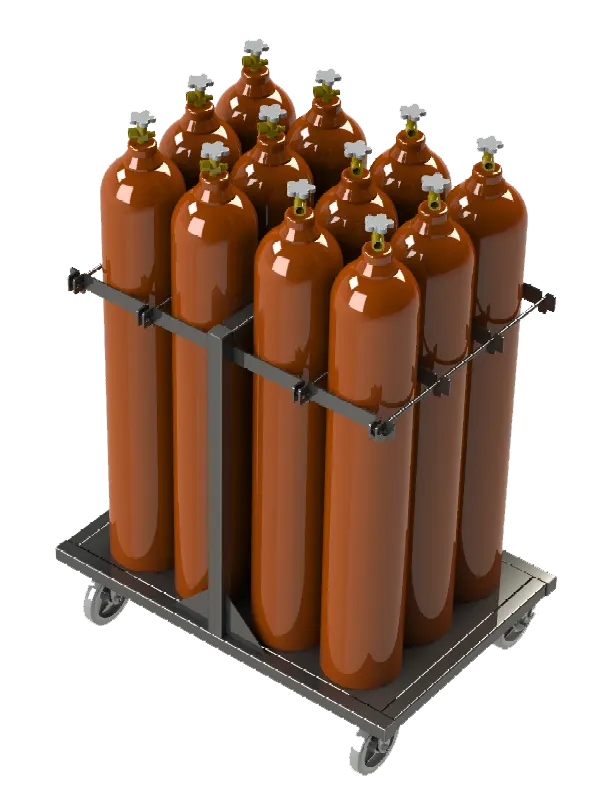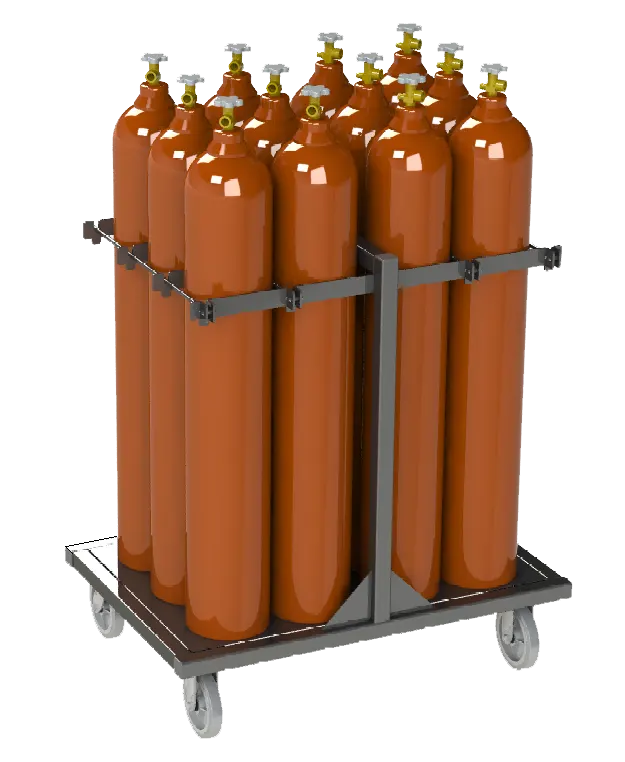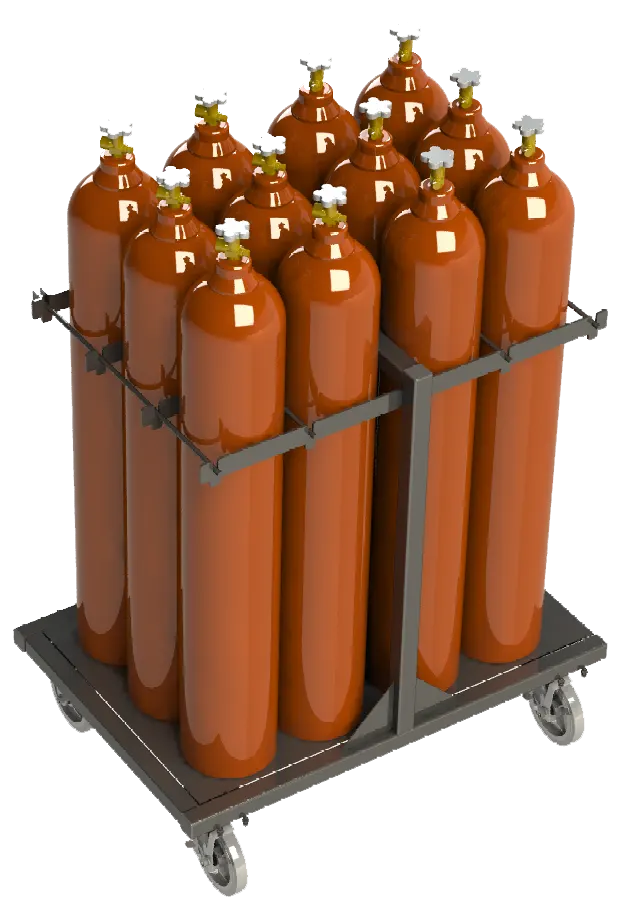Discover how stack racks can maximize storage space, improve organization, and enhance efficiency in various industries.
Read More
Gas cylinders are extensively utilized in numerous sectors to store and transport gases. Pressurized gases contained in these cylinders have the potential to be extremely volatile and hazardous if not handled carefully. It is crucial to guarantee the safety of gas cylinder transportation in order prevent accidents and protect people and assets alike. The gas cylinder transport rack is an essential part that is vital to the safe transportation of gas cylinders.

What is a Gas Cylinder Transport Rack?
A gas cylinder transport rack is a specialized equipment designed to safely handle and transport gas cylinders. To ensure strength and endurance, these racks are often composed of robust materials such as steel or aluminum. They are built with specialized features and combinations to fit various gas cylinder sizes and types. A gas cylinder transport rack’s principal purpose is to ensure the safe transportation of gas cylinders by reducing the risk of cylinder breakage, leaking, or falling.
Why is a Gas Cylinder Transport Rack Important?
Transport racks for gas cylinders are necessary for a number of reasons. They offer a safe and sturdy platform for the transportation of gas cylinders first and foremost. Because of the rack’s construction, there is less chance of an accident occurring when cylinders tip over or roll while being transported. Additionally, gas cylinder transport racks have provisions for securing the cylinders in place using various locking mechanisms, adding an extra layer of safety.
Another important feature of gas cylinder transport racks is their ability to keep the cylinders safe from physical harm. These racks usually have cushioning or padding to reduce shocks and vibrations during transportation, lowering the danger of cylinder breakage or leaking. Transport racks help maintain cylinder integrity and enable safe gas transportation by keeping them firmly in place and protecting them from external factors.
Types of Gas Cylinder Transport Racks
Gas cylinder transport racks are available in various designs and configurations to cater to different needs and requirements. The most common types include:
-
Vertical Cylinder Racks: These racks hold cylinders vertically, allowing for easy loading and unloading. Essentially, they are suitable for applications where space is limited, as they have a relatively small footprint.
-
Horizontal Cylinder Racks: Horizontal racks secure cylinders in a horizontal position, typically stacked one over the other. In essence, they are ideal for transporting a large number of cylinders and are commonly used in industrial settings.
-
Wall-Mounted Cylinder Racks: These racks are affixed to walls, providing a space-saving solution for cylinder storage and transportation. Furthermore, they are commonly used in laboratories and medical facilities where a limited floor space is available.
-
Custom Cylinder Racks: Some applications may require specialized cylinder racks designed to fit unique cylinder sizes or specific transportation needs. These custom racks are tailored to meet the specific requirements of the industry or application.
Choosing the proper form of gas cylinder transport rack is determined by the quantity of cylinders to be transported, available space, and specific handling needs. It is critical to choose a rack that protects the gas cylinders while also providing convenience during transit.
How does a Gas Cylinder Transport Rack Work?
Gas cylinder transport racks are designed with features and mechanisms that work together to ensure the safe transportation of cylinders. Here is a brief overview of how a typical gas cylinder transport rack functions:
-
Securing Gas Cylinders: The rack is firmly filled with gas cylinders to keep them steady and prevent them from rolling or toppling over while being transported. Most racks have provisions for securing cylinders using straps, chains, or brackets.
-
Shock Absorption: In order to reduce shocks and vibrations during transportation, gas cylinder transport racks frequently include padding or cushioning materials. This lessens the chance that the cylinders will sustain damage from mishandling or unintentional collisions.
-
Locking Mechanisms: Transport racks have locking devices that keep the cylinders firmly in place. These methods range from simple clips to more complex locking systems, ensuring that the cylinders remain secure throughout the transit procedure.
-
Loading and Unloading Ease: Gas cylinder transport racks are designed to enable easy loading and unloading of cylinders, minimizing the risk of manual handling injuries. They often feature ramps or other mechanisms to facilitate smooth and ergonomic movement of cylinders.
By combining these features, a gas cylinder transport rack provides a reliable and efficient way to transport gas cylinders safely, minimizing the risks associated with transportation.
Safety Considerations for Gas Cylinder Transportation
Transporting gas cylinders requires careful attention to safety to prevent accidents, injuries, or damage. Some essential safety considerations when using a gas cylinder transport rack include:
1. Cylinder Compatibility:
It is critical to ensure that the transport rack is appropriate for the particular type and size of cylinders being transported. Using an incompatible rack may cause instability or damage to the cylinders.
2. Weight Capacity:
Gas cylinder transport racks have weight limits that should not be exceeded. Therefore, overloading the rack can compromise its integrity and increase the risk of accidents.
3. Stability:
Ensuring that the gas cylinders are securely positioned and locked within the rack is vital for stability during transport. Any loose or unsecured cylinders can be hazardous if they shift or fall while in transit.
4. Proper Handling:
Loading, unloading, and securing cylinders into the transport rack requires correct handling practices. This involves utilizing the proper lifting procedures, fastening cylinders tightly, and avoiding rough or sudden movements.
5. Ventilation:
Some gas cylinders may require proper ventilation during transit to avoid the accumulation of potentially harmful gasses. When purchasing or operating a gas cylinder transport rack, ventilation requirements must be considered.
By adhering to these safety considerations and best practices, the risk of accidents or incidents during gas cylinder transportation can be significantly reduced.

How to Choose the Right Gas Cylinder Transport Rack
Selecting the appropriate gas cylinder transport rack is critical for ensuring the safe and efficient transportation of gas cylinders. Here are some factors to consider when choosing a gas cylinder transport rack:
1. Cylinder Size and Type:
Ensure that the transport rack is compatible with the size and type of cylinders you intend to transport. Consider the diameter, height, and valve configuration of the cylinders to ensure a proper fit.
2. Weight Capacity:
Determine the rack’s maximum weight capacity and make sure it can handle the total weight of the cylinders you intend to transport. It is critical not to exceed the weight restriction set by the manufacturer.
3. Rack Configuration:
Choose a rack configuration (vertical, horizontal, wall-mounted, etc.) that suits your transportation needs and available space. Consider factors such as ease of loading and unloading, maneuverability, and storage requirements.
4. Security Features:
Look for racks with dependable and durable locking mechanisms to keep the cylinders in place during travel. These characteristics serve to keep cylinders from shifting, tipping over, or tumbling off the rack.
5. Material and Construction:
Consider the material and construction quality of the gas cylinder transport rack. Steel or aluminum racks offer durability and strength, ensuring a long service life and resistance to corrosion and impacts.
6. Compliance with Regulations:
Ensure that the gas cylinder carrying rack adheres to the regulations and standards outlined earlier in this article. Compliance assures that the rack has passed the appropriate testing and certifications to ensure its safety and reliability.
By carefully considering these factors and choosing a gas cylinder transport rack that meets your specific requirements, you can ensure the safe transportation of gas cylinders while optimizing efficiency and minimizing risks.
Benefits of Using a Gas Cylinder Transport Rack
Using a gas cylinder transport rack offers several benefits, including:
-
Enhanced Safety: Gas cylinder transport racks provide a safe and sturdy platform for moving cylinders, reducing the likelihood of accidents and cylinder damage. They also prevent leaks, which ensures the safety of both personnel and property.
-
Increased Efficiency: By using a transport rack, the loading, unloading, and transportation of gas cylinders can be done more efficiently. As a result, this saves time and effort, allowing for more streamlined operations.
-
Improved Cylinder Protection: Gas cylinder transport racks provide cushioning and protection from shocks and vibrations during transport. This helps to maintain the integrity of cylinders, lowering the danger of damage or leakage.
-
Easier Compliance with Regulations: Using a gas cylinder transport rack that complies with regulatory standards simplifies the process of adhering to legal requirements. Ultimately, this ensures that organizations transporting gas cylinders meet safety and regulatory guidelines.
-
Space Optimization: Transport racks exist in a variety of layouts, allowing for more efficient use of limited space. Wall-mounted racks, for example, offer a space-saving alternative, especially in areas with limited floor space.
By leveraging these benefits, organizations can enhance the safety, efficiency, and compliance of their gas cylinder transportation processes.
Features to Look for in a Gas Cylinder Transport Rack
When selecting a gas cylinder transport rack, consider the following features to ensure the rack meets your specific requirements:
-
Durability: Choose a rack made of sturdy and corrosion-resistant materials like steel or aluminum. Basically, this will ensure a long service life and resistance to wear and tear.
-
Secure Locking Mechanisms: Look for racks with dependable locking mechanisms to keep the cylinders in place during shipment. These mechanisms should be simple to use while also providing strong and reliable cylinder support.
-
Shock Absorption: Gas cylinder transport racks with cushioning or padding materials help to absorb shocks and vibrations, preventing cylinder damage during transport.
-
Ease of Use: Consider features that facilitate easy loading, unloading, and maneuverability, such as ramps, handles, or swivel wheels. Consequently, these features will enhance operational efficiency and reduce the risk of manual handling injuries.
-
Compatibility: Ensure that the transport rack is compatible with the size and type of cylinders you intend to transport. Essentially, the rack should have adjustable configurations or options for accommodating different cylinder sizes.
-
Compliance: Check to make sure the transport rack complies with all applicable laws, rules, and certifications. This ensures that the rack has undergone rigorous testing and complies with safety and quality requirements.
By considering these features, you can choose a gas cylinder transport rack that meets your specific needs and provides optimal safety and performance.

Training and Education for Gas Cylinder Transportation Safety
Proper training and education are crucial for ensuring the safe transportation of gas cylinders using a transport rack. Here are some key elements to consider in a comprehensive training program:
-
Proper Handling Techniques: Train personnel on correct lifting, carrying, and loading techniques to prevent injuries and accidents. Emphasize the use of appropriate personal protective equipment (PPE) and adherence to safety protocols.
-
Transport Rack Operation: Provide training on how to use the gas cylinder carrying rack correctly. Cover subjects including fastening cylinders, employing locking mechanisms, and understanding the rack’s unique features and limitations.
-
Safety Guidelines and Regulations: Inform staff members about relevant industry standards, laws, and safety precautions relating to the transportation of gas cylinders. Ensure they understand their roles and what to do in the event of an emergency, including emergency response protocols.
-
Emergency Response Training: Conduct training sessions on emergency response procedures for handling potential incidents during gas cylinder transportation. This should include evacuation protocols, first aid, and how to handle leaks or spills.
-
Regular Refresher Training: Schedule frequent refresher training sessions to reinforce safe practices and keep staff up to date on any new rules, technologies, or best practices for transporting gas cylinders.
-
Documentation and Reporting: Educate staff members on the value of precise reporting and documentation. Stress the importance of keeping records of all inspections, maintenance procedures, and any incidents or near misses involving the transportation of gas cylinders.
By investing in proper training and education for employees involved in gas cylinder transportation, organizations can ensure a safer work environment, reduce the risk of accidents, and maintain compliance with regulatory requirements.
Conclusion
The usage of gas cylinder transport racks is critical to guaranteeing gas cylinder safety and efficiency during transportation. These racks considerably decrease the risk of accidents, injuries, and property damage by securely retaining cylinders, protecting them from damage, and ensuring regulatory compliance. When selecting a gas cylinder transport rack, consider cylinder compatibility, weight capacity, configuration, and industry standard compliance. Proper use, maintenance, and regular personnel training are also critical to ensuring safety. As the industry evolves, new technologies, sustainable materials, and customization options present opportunity to improve safety, efficiency, and overall performance. By working with reputable suppliers and staying up-to-date with industry trends, organizations can ensure the safe and successful transportation of gas cylinders using gas cylinder transport racks.









